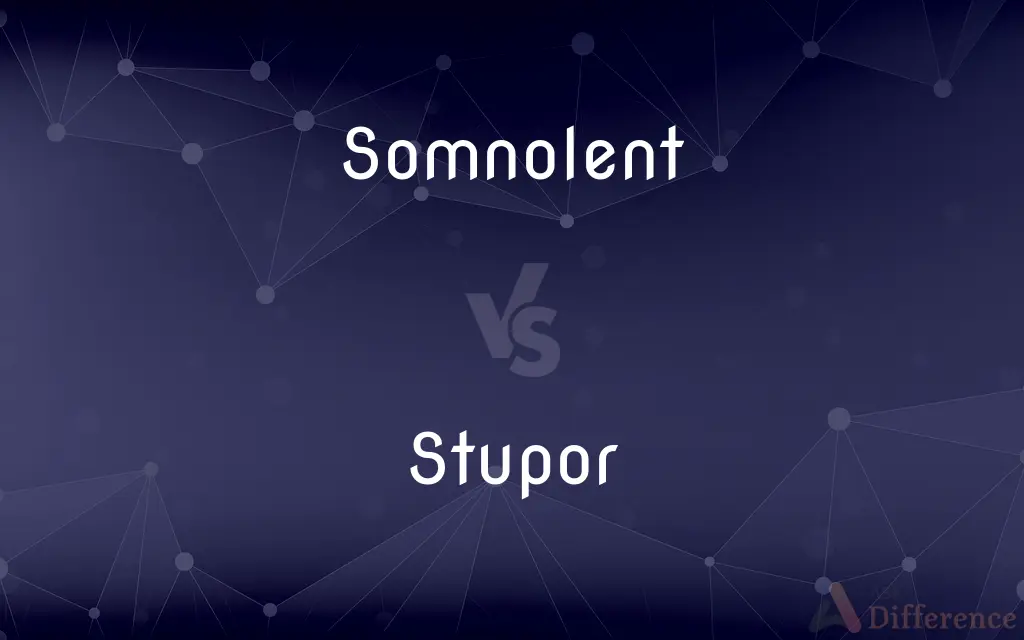Somnolent vs. Stupor — What's the Difference?
Edited by Tayyaba Rehman — By Urooj Arif — Updated on April 16, 2024
Somnolent describes a state of drowsiness or sleepiness, while stupor refers to a near-unconscious condition marked by reduced reaction to stimuli.

Difference Between Somnolent and Stupor
Table of Contents
ADVERTISEMENT
Key Differences
Somnolent is often used to describe someone who is sleepy or drowsy, indicating a mild, natural inclination towards sleep. On the other hand, stupor describes a much more severe condition, where an individual exhibits greatly diminished awareness and responsiveness to the environment.
In medical or clinical contexts, being somnolent can simply mean the need for sleep due to tiredness or sedative effects. Whereas, stupor is usually a result of more serious issues such as brain injuries, intoxication, or illnesses that affect the brain, reflecting a state of near-unconsciousness.
People who are somnolent are typically able to be awakened with mild stimuli, like a loud noise or a gentle shake. On the other hand, those in a stupor require much more significant effort to elicit even a slight response, and may not be easily awakened.
The somnolent state is generally reversible with enough rest or the cessation of the sedative cause. Conversely, stupor might require medical intervention to address the underlying cause and to restore consciousness levels.
While somnolence can be seen as a sign of a healthy need for sleep or a benign side effect of a medication, stupor is often considered a medical emergency that could indicate life-threatening conditions.
ADVERTISEMENT
Comparison Chart
Definition
A state of drowsiness or sleepiness.
A state of near-unconsciousness.
Cause
Often due to lack of sleep or sedatives.
Caused by more severe factors like injury or intoxication.
Responsiveness to Stimuli
Responsive to mild stimuli.
Requires intense stimuli for response.
Reversibility
Usually reversible with sleep or cessation of cause.
May require medical intervention.
Associated Conditions
Sleep deprivation, medication side effects.
Brain injuries, severe intoxication, illnesses.
Compare with Definitions
Somnolent
Inclined to or heavy with sleep; drowsy.
After the long meeting, he felt unusually somnolent.
Stupor
Marked by a lack of critical cognitive function.
The fever brought him to a stupor where he couldn't recognize his own family.
Somnolent
Characterized by sleepiness or drowsiness.
The medication can make patients somnolent.
Stupor
Reflecting a severe reduction in responsiveness to external stimuli.
After the overdose, the patient was in a stupor.
Somnolent
Sleep-inducing; soporific.
The lecturer's monotone voice had a somnolent effect on the audience.
Stupor
A condition of greatly dulled or completely suspended sense or sensibility.
The trauma left him in a stupor.
Somnolent
Causing or suggestive of drowsiness.
The dim lighting and soft music were somnolent.
Stupor
A state of mental numbness as from shock.
He wandered around in a stupor after hearing the tragic news.
Somnolent
Pertaining to the state just before falling asleep.
In his somnolent state, he barely heard the phone ring.
Stupor
A state of near-unconsciousness or insensibility.
She was found in a stupor, unresponsive to her surroundings.
Somnolent
Drowsy; sleepy.
Stupor
Stupor is the lack of critical mental function and a level of consciousness, in which an affected person is almost entirely unresponsive and responds only to intense stimuli such as pain. The word derives from the Latin stupor ("numbness, insensibility").
Somnolent
Inducing or tending to induce sleep; soporific.
Stupor
A state of reduced sensibility or consciousness
Staggered around in a drunken stupor.
Somnolent
Drowsy or sleepy.
Stupor
A state of greatly dulled or completely suspended consciousness or sensibility; a chiefly mental condition marked by absence of spontaneous movement, greatly diminished responsiveness to stimulation, and usually impaired consciousness.
Somnolent
(dated) Causing literal or figurative sleepiness.
Stupor
A state of extreme apathy or torpor resulting often from stress or shock.
Somnolent
Sleepy; drowsy; inclined to sleep.
He had no eye for such phenomena, because he had a somnolent want of interest in them.
Stupor
To place into a stupor; to stupefy.
Somnolent
Inclined to or marked by drowsiness;
Slumberous (or slumbrous) eyes
`slumbery' is archaic
The sound had a a somnolent effect
Stupor
Great diminution or suspension of sensibility; suppression of sense or feeling; lethargy.
Stupor
Intellectual insensibility; moral stupidity; heedlessness or inattention to one's interests.
Stupor
The feeling of distress and disbelief that you have when something bad happens accidentally;
His mother's deathleft him in a daze
He was numb with shock
Stupor
Marginal consciousness;
His grogginess was caused as much by exhaustion and by the blows
Someone stole his wallet while he was in a drunken stupor
Common Curiosities
What is the main difference between feeling somnolent and being in a stupor?
Feeling somnolent is essentially feeling sleepy, whereas being in a stupor involves a significant reduction in alertness and responsiveness, approaching unconsciousness.
Is it safe to wake someone who is somnolent?
Yes, it is generally safe to wake someone who is somnolent as it is a mild form of sleepiness.
Can everyday activities induce somnolence?
Yes, everyday activities like reading, watching TV, or even overeating can induce a state of somnolence.
Are there long-term effects associated with recurrent somnolence?
Recurrent somnolence could lead to long-term effects like cognitive impairment, increased risk of accidents, and health issues if underlying causes such as sleep disorders are not treated.
What medications can induce somnolence?
Many medications including antihistamines, certain pain relievers, and anti-anxiety drugs can induce somnolence as a side effect.
Can children enter a stupor? What are the implications?
Children can enter a stupor due to severe illnesses, intoxication, or head injuries. It is critical to treat it promptly to avoid potential long-term neurological damage.
What should one do if they find someone in a stupor?
Immediate medical help should be sought if someone is found in a stupor, as it may indicate a life-threatening condition.
What are common causes of a stupor?
Common causes include severe head injuries, drug or alcohol intoxication, infections affecting the brain, and severe metabolic disturbances.
How do medical professionals assess someone in a stupor?
Medical professionals use various neurological scales and tests to assess responsiveness, check reflexes, and evaluate cognitive functions.
What diagnostic tools are used to understand the cause of stupor?
Diagnostic tools may include blood tests, imaging studies like CT scans or MRIs, and sometimes lumbar punctures to assess brain conditions.
Are there specific treatments used to reverse stupor?
Treatments depend on the cause but may include administering antidotes for intoxication, managing infections, or stabilizing brain pressure.
Can fatigue cause somnolence?
Yes, general fatigue from lack of sleep or excessive physical activity can lead to somnolence.
Share Your Discovery

Previous Comparison
Deli vs. Shop
Next Comparison
Translucent vs. ScrimAuthor Spotlight
Written by
Urooj ArifUrooj is a skilled content writer at Ask Difference, known for her exceptional ability to simplify complex topics into engaging and informative content. With a passion for research and a flair for clear, concise writing, she consistently delivers articles that resonate with our diverse audience.
Edited by
Tayyaba RehmanTayyaba Rehman is a distinguished writer, currently serving as a primary contributor to askdifference.com. As a researcher in semantics and etymology, Tayyaba's passion for the complexity of languages and their distinctions has found a perfect home on the platform. Tayyaba delves into the intricacies of language, distinguishing between commonly confused words and phrases, thereby providing clarity for readers worldwide.
















































